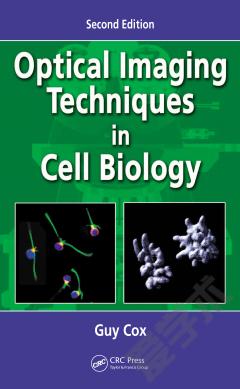Optical Imaging Techniques in Cell Biology
The Light Microscope Lenses and Microscopes The Back Focal Plane of a Lens Good Resolution Resolution: Rayleigh's Approach Abbe Add a Drop of Oil Koehler Illumination Optical Contrasting Techniques Darkfield Phase Contrast Polarization Differential Interference Contrast Hoffman Modulation Contrast Which Technique Is Best? Fluorescence and Fluorescence Microscopy What Is Fluorescence? What Makes a Molecule Fluorescent? The Fluorescence Microscope Optical Arrangement Light Source Filter Sets: Excitation Filter, Dichroic Mirror, and Barrier Filter Image Capture Optical Layout for Image Capture Color Recording Additive Color Model Subtractive Color Model CCD Cameras Frame-Transfer Array Interline-Transfer Array Back Illumination Binning Recording Color Filter Wheels Filter Mosaics Three CCD Elements with Dichroic Beamsplitters Boosting the Signal The Confocal Microscope The Scanning Optical Microscope The Confocal Principle Resolution and Point Spread Function Lateral Resolution in the Confocal Microscope Practical Confocal Microscopes The Light Source: Lasers Gas Lasers Solid-State Lasers Semiconductor Lasers Supercontinuum Lasers Laser Delivery The Primary Beamsplitter Beam Scanning Pinhole and Signal Channel Configurations Detectors The Digital Image Pixels and Voxels Contrast Spatial Sampling: The Nyquist Criterion Temporal Sampling: Signal-to-Noise Ratio Multichannel Images Aberrations and Their Consequences Geometrical Aberrations Spherical Aberration Coma Astigmatism Field Curvature Chromatic Aberration Chromatic Difference of Magnification Practical Consequences Apparent Depth Nonlinear Microscopy Multiphoton Microscopy Principles of Two-Photon Fluorescence Theory and Practice Lasers for Nonlinear Microscopy Advantages of Two-Photon Excitation Construction of a Multiphoton Microscope Fluorochromes for Multiphoton Microscopy Second Harmonic Microscopy Summary High-Speed Confocal Microscopy Tandem Scanning (Spinning Disk) Microscopes Petran System One-Sided Tandem Scanning Microscopes (OTSMS) Microlens Array: The Yokogawa System Slit-Scanning Microscopes Multipoint-Array Scanners Structured Illumination Deconvolution and Image Processing Deconvolution Deconvolving Confocal Images Image Processing Grayscale Operations Image Arithmetic Convolution: Smoothing And Sharpening Three-Dimensional Imaging: Stereoscopy and Reconstruction Surfaces: Two-And-A-Half Dimensions Perception of the 3D World Motion Parallax Convergence and Focus of Our Eyes Perspective Concealment of One Object by Another Our Knowledge of the Size and Shape of Everyday Things Light and Shade Limitations of Confocal Microscopy Stereoscopy Three-Dimensional Reconstruction Techniques That Require Identification of "Objects" Techniques That Create Views Directly from Intensity Data Simple Projections Weighted Projection (Alpha Blending) Green Fluorescent Protein Structure and Properties of GFP GFP Variants Applications of GFP Heat Shock Cationic Lipid Reagents DEAE-Dextran And Polybrene Calcium Phosphate Coprecipitation Electroporation Microinjection Gene Gun Plants: Agrobacterium Fluorescent Staining, Teresa Dibbayawan, Eleanor Kable, and Guy Cox Immunolabeling Types of Antibody Raising Antibodies Labeling Fluorescent Stains for Cell Components and Compartments Quantitative Fluorescence Fluorescence Intensity Measurements Linearity Calibration Measurement Colocalization Ratio Imaging Cell Loading Membrane Potential Fast-Response Dyes Slow-Response Dyes Fluorescence Recovery after Photobleaching Advanced Fluorescence Techniques: FLIM, FRET, and FCS Fluorescence Lifetime Practical Lifetime Microscopy Frequency Domain Time Domain Fluorescence Resonant Energy Transfer (FRET) Why Use FRET? Identifying And Quantifying Fret Increase in Brightness of Acceptor Emission Quenching of Emission from the Donor Lifetime of Donor Emission Protection from Bleaching of Donor Fluorescence Correlation Spectroscopy (FCS) Raster Image Correlation Spectroscopy Evanescent Wave Microscopy The Near-Field and Evanescent Waves Total Internal Reflection Microscopy Near-Field Microscopy Beyond the Diffraction Limit 4Pi and Multiple-Objective Microscopy Stimulated Emission Depletion (STED) Structured Illumination Stochastic Techniques Super-Resolution Summary Appendix A: Microscope Care and Maintenance Cleaning The Fluorescent Illuminator Appendix B: Keeping Cells Alive under the Microscope, Eleanor Kable and Guy Cox Chambers Light Movement Finally Appendix C: Antibody Labeling of Plant and Animal Cells: Tips and Sample Schedules, Eleanor Kable and Teresa Dibbayawan Antibodies: Tips on Handling and Storage Pipettes: Tips on Handling Antibodies and Antibody Titrations Example Immunofluorescence Protocol Method Multiple Labeling and Different Samples Plant Material Protocol Diagram Showing Position of Antibodies on Multiwell Slide Appendix D: Image Processing with ImageJ, Nuno Moreno Introduction Different Windows in ImageJ Image Levels Colors and Look-Up Tables Size Calibration Image Math Quantification Stacks and 3D Representation FFT and Image Processing Macro Language in ImageJ Index
{{comment.content}}








 京公网安备 11010802027623号
京公网安备 11010802027623号